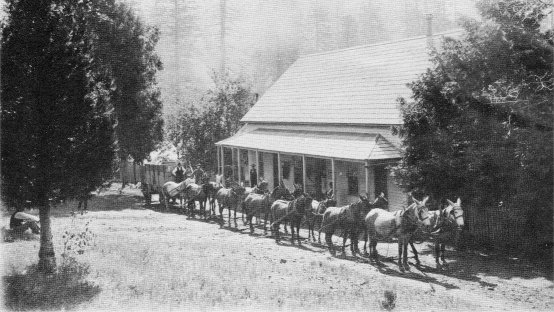
[click to enlarge]
CROCKER’S STATION WAS WESTERN TERMINUS OF THE GREAT SIERRA WAGON ROAD
| Online Library: | Title | Author | California | Geology | History | Indians | Muir | Mountaineering | Nature | Management |
Yosemite > Library > Ghost Mines > 16. Great Sierra Wagon Road >
Next: 17. Intrigue • Contents • Previous: 15. Going was Rough

[click to enlarge] CROCKER’S STATION WAS WESTERN TERMINUS OF THE GREAT SIERRA WAGON ROAD |
THOUSANDS OF VISITORS to Yosemite National Park have traveled the famed Tioga Road, over the highest automobile pass in California, without knowing the interesting story of how it happened to be built. With the cutting of the Sheepherder vein but a matter of time, the Board of Directors of the Great Sierra Company were faced with
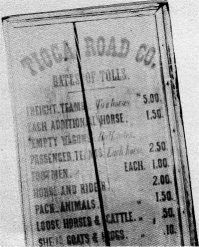
[click to enlarge] |
A wagon road up the more gentle western slope of the Sierra seemed to be the answer, and Charles Barney was the man to do the job. The 41 year old New Bedford engineer had as his assistant William C. Priest, builder of Priest’s Grade on the Yosemite route southeast of Sonora. The men who were caught in the snowstorm on the Tioga trail, H. B. Carpenter and Harry P. Medlicott, surveyed the route and supervised the road crews.
The construction of the Great Sierra Wagon Road was an epic of western roadbuilding. A report from Barney to Bennett dated November 1, 1883 advised that, “The operations of your company for the year 1883 have been confined principally to pushing forward the tunnel for the development of the Sheepherder’s and Great Sierra ledges and building a wagon road to the mines. Work on the wagon road was begun on April 27, 1883 and it was carried forward without interruption or accident until finally completed September 4, 1883. The road leaves the Big Oak Flat and Yosemite Valley Stage Road at a point near Crocker’s Station and continues in an easterly direction [via Aspen Valley, White Wolf, and Tuolumne Meadows] to . . . Bennettville. The total length of the road is 56½ miles and it has been constructed throughout in a most substantial manner. . .
“It is without doubt the most direct, and on account of its low grades, the easiest road for freight teams crossing the Sierra Nevada mountains, and it cannot but prove a good investment for the Company, not only on account of reducing the price of its freight at least one half, but on account of the income to be derived from tolls, which will probably be large.” 47
Barney’s report indicates that only 130 days were required to construct a road 56½ miles in length. Over rugged and mountainous terrain, his crew of Chinese and white laborers, some 160 strong, 48 but working almost entirely with hand tools, averaged almost one half mile a day. Cost of constructing the wagon road, which went from an elevation of 4200 feet at Crocker’s Station to nearly 10,000 feet at the summit of McLean’s (Tioga) Pass, was reported to have been $61,000. 49
August 11, 1883 — The Great Sierra Wagon Road is rapidly approaching completion. Wagons from the other side were to have reached Lake Tenaya yesterday. Harry Medlicott’s graders from this side have reached the upper end of Tuolumne Meadows, while Priest’s pick and shovel brigade from the other side
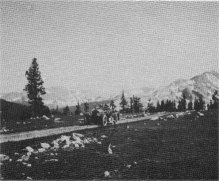
[click to enlarge] AUTO NEAR TIOGA PASS, ABOUT 1915 |
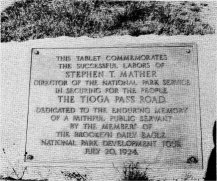
[click to enlarge] MATHER PLAQUE, TIOGA PASS |
The road was operated for a period as a toll road by William Priest, but Barney’s optimism of its future was based largely on anticipated completion of an additional four miles down Lake Canyon to Lundy to give a through route across the Sierra. This stretch was never finished, and the present road down Lee Vining Canyon was not completed by the State of California until 1911. 51
The Great Sierra Wagon Road soon fell into disrepair after the collapse of the Great Sierra Company, and remained neglected until its purchased in 1915 for $15,500 by Stephen T. Mather, dynamic first director of the National Park Service, with the help of the Sierra Club and others. 52 Following its acquisition from members of the Swift family of new Bedford, the road was deeded to the Federal Government.
Much realignment has taken place and the 21 miles of the original road remaining in use today (1958) are scheduled for realignment. But in spite of its narrowness and its steep grades this old road gives the traveler an opportunity to see and to enjoy what Jim Townsend called, “the very grandest scenery in the world.” 53
And with a little imagination one can almost expect to see Barney and Priest and their sweating coolies, just around the next curve.
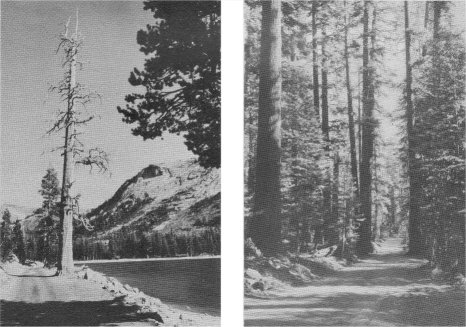
[click to enlarge] THE OLD TIOGA ROAD PASSED ALONG LAKE TENAYA AND THROUGH STATELY FORESTS. |
Next: 17. Intrigue • Contents • Previous: 15. Going was Rough
| Online Library: | Title | Author | California | Geology | History | Indians | Muir | Mountaineering | Nature | Management |
http://www.yosemite.ca.us/library/ghost_mines/wagon_road.html